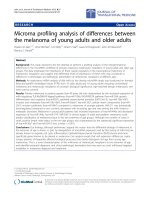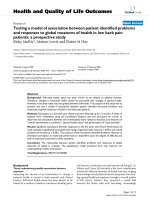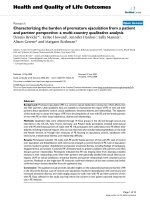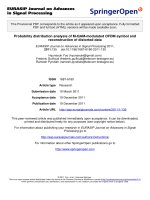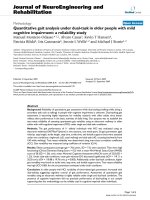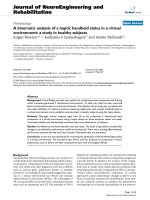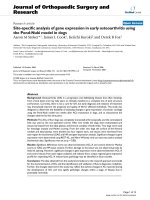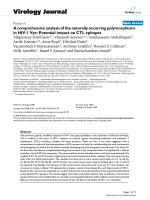Báo cáo hóa học: " Quantitative expression analysis of HHV-6 cell receptor CD46 on cells of human cord blood, peripheral blood and G-CSF mobilised leukapheresis cells" docx
Bạn đang xem bản rút gọn của tài liệu. Xem và tải ngay bản đầy đủ của tài liệu tại đây (221.43 KB, 4 trang )
BioMed Central
Page 1 of 4
(page number not for citation purposes)
Virology Journal
Open Access
Short report
Quantitative expression analysis of HHV-6 cell receptor CD46 on
cells of human cord blood, peripheral blood and G-CSF mobilised
leukapheresis cells
Stefanie Thulke*
1
, Aleksandar Radonić
2
, Andreas Nitsche
3
and
Wolfgang Siegert
4
Address:
1
Charité-Universitätsmedizin Berlin, CCM – Medizinische Klinik m.S. Onkologie/Hämatologie, Charitéplatz 1, 10117 Berlin, Germany,
2
Charité-Universitätsmedizin Berlin, CCM – Medizinische Klinik m.S. Onkologie/Hämatologie, Charitéplatz 1, 10117 Berlin, Germany,
3
Robert
Koch Institut, ZBS 1, Nordufer 20, 13353 Berlin, Germany and
4
Charité-Universitätsmedizin Berlin, CCM – Medizinische Klinik m.S. Onkologie/
Hämatologie, Charitéplatz 1, 10117 Berlin, Germany
Email: Stefanie Thulke* - ; Aleksandar Radonić - ; Andreas Nitsche - ;
Wolfgang Siegert -
* Corresponding author
Abstract
Human herpesvirus-6 (HHV-6) can infect blood cells and thereby may inhibit hematopoietic stem
and progenitor cell expansion and differentiation. In this context, it has been discussed if early
progenitor cells can be infected by HHV-6. CD46 was identified as one possible cellular surface
receptor for HHV-6. The study presented here had been done to get insight into the susceptibility
of various leukocyte subpopulations to HHV-6 (including early hematopoietic progenitors) by
determining the amount of CD46 molecules expressed on their surfaces. Human cord blood cells,
peripheral blood cells and G-CSF mobilised progenitor cells were analysed by flow cytometry.
CD46 molecule number per cell was determined and compared to calibration beads conjugated
with known ratio of PE per bead. Highest CD46 expression was detected on B- lymphocytes,
whereas T-lymphocytes only showed about half of the amount found on B cells. Hematopoietic
progenitors also carried CD46 at intermediate levels. Unexpectedly, CD46 expression on
progenitors from G-CSF mobilised leukapheresis products was approximately 20% of that found
on comparable cells from untreated cord blood. In conclusion, hematopoietic progenitor cells
express CD46 on their surface, thereby fulfilling a basic requirement for the susceptibility of HHV-
6 infection.
Findings
Human herpesvirus-6 (HHV-6) was first isolated in 1986
[1]. To date all HHV-6 isolates can be differentiated into
the variants HHV-6A and HHV-6B. In early childhood
HHV-6B infection causes exanthema subitum and febrile
illness. After primary infection, HHV-6 persists life-long in
host cells and may be reactivated under conditions of
immunosuppression, thereby causing various, in some
extend life-threatening diseases, including mononucleo-
sis, lymphoid/hematopoietic diseases, myelosuppression,
encephalitis, pulmonitis and hepatitis [2]. HHV-6
induced myelosuppression, as occurring after stem cell
transplantation, is recognised by leuko- and thrombocy-
topenia. Moreover, we showed that early HHV-6B infec-
Published: 19 September 2006
Virology Journal 2006, 3:77 doi:10.1186/1743-422X-3-77
Received: 20 January 2006
Accepted: 19 September 2006
This article is available from: />© 2006 Thulke et al; licensee BioMed Central Ltd.
This is an Open Access article distributed under the terms of the Creative Commons Attribution License ( />),
which permits unrestricted use, distribution, and reproduction in any medium, provided the original work is properly cited.
Virology Journal 2006, 3:77 />Page 2 of 4
(page number not for citation purposes)
tions may contribute to delayed platelet engraftment after
stem cell transplantation [3]. There have been evidences
for latently HHV-6 infected hematopoietic progenitors
reactivating HHV-6 replication within the graft [4,5]. Our
own studies showed that HHV-6A as well as HHV-6B are
able to infect cord blood (CB) derived mononuclear cells
and thereby inhibit in vitro expansion of the total cell
number and of BFU-e, CFU-GM, as well as CD34
+
or
CD33
+
cells. Contrariwise we could show only less HHV-
6 mediated inhibition of CD34
+
cell expansion of MACS
separated CB CD34
+
cells [6]. So far we have had no suc-
cess to show an infected CD34
+
cell. In order to clarify the
role of HHV-6 in early hematopoietic stem cell develop-
ment, we were interested in determining the level of dif-
ferentiation when blood cells, especially early
hematopoietic progenitor cells, became susceptible for
HHV-6 infection. We believed that this question might be
answered by quantifying HHV-6 membrane receptor
CD46. CD46 was identified as cellular surface receptor for
HHV-6 in 1999 [7] by interaction with viral glycoprotein
complex gH-gL-gQ [8]. CD46 is the cellular receptor for
further pathogens: Measles virus, group B adenoviruses
[9] and other pathogenic microorganisms [10,11]. It is
also known to act as a membrane cofactor for factor-I pro-
teolytic cleavage of C3b and C4b in complement activa-
tion. CD46 also affects various cellular activities in
response to pathogen or complement binding, and thus
influences the host response to infection [12]. Recently,
analysis of the short consensus repeat (SCR) regions that
comprise most of the extracellular domain of CD46, was
shown to have an essential role of SCR 2 and 3 in HHV-6
receptor activity [13].
We analysed samples of peripheral blood (PB) of healthy
adults, CB, G-CSF mobilised peripheral blood progenitor
cells collected as leukapheresis product (LP), and the
HHV-6 infectable cell lines KG-1 and CRF-HSB-2 with
regard to CD46 expression. In addition, we analysed
CD34
+
hematopoietic precursor cells purified by MACS
separation (Miltenyi Biotec GmbH, Bergisch Gladbach,
Germany). Heparinised blood was diluted 1:10 in FACS
lysing Solution (Becton Dickinson, Heidelberg, Germany)
to lyse erythrocytes and cells were washed twice in PBS.
The cells were stained with the following monoclonal
antibodies (mAB) for 15 min at room temperature: R-PE
conjugated anti-CD46 (Cymbus Biotechnology LTD,
Chandlers Ford, UK) and PerCP conjugated anti-CD45
(Becton Dickinson). To characterise different blood cell
types, cells were stained with the following FITC conju-
gated mAB: anti-CD3, anti-CD8, anti-CD13, anti-CD15,
anti-CD19, anti-CD22, anti-CD28, anti-CD33, anti-
CD38, anti-CD45, anti-CD65 (Beckman Coulter GmbH,
Unterschleissheim-Lohhof, Germany), anti-CD4, anti-
CD14, (Becton Dickinson), anti-CD34 (Miltenyi Biotec
GmbH). All FACS analyses were performed using the FAC-
SCalibur (Becton Dickinson). Levels of CD46 expression
were determined in reference to calibration beads conju-
gated with a known ratio of PE per bead (QuantiBRITE PE
conjugated beads, Becton Dickinson).
Levels of CD46 obtained on T and B-lymphocytes of CB,
PB and LP are shown in figure 1. CD46 expression on B-
lymphocytes (CD22
+
, CD19
+
cells) was significantly
higher than on T-lymphocytes from CB and PB. Highest
CD46 expression levels were detected on CD22
+
B-cells,
the median number of molecules per CD22
+
cell in CB, PB
and LP was 11,650 (range, 10,702–14,158), 17,490
(range, 13,772–19,997) and 9,618 (range, 4,339–
10,774), respectively. On CD19
+
B-cells the median
number of CD46 molecules per cell in CB, PB and LP was
9190 (range, 5,807–11,437), 11,060 (range, 10,378–
Detection of CD46 molecules on cell membranes of mature leukocytes from cord blood (CB), [A, squares], peripheral blood of adult donors (PB), [B, circles] and leukapheresis products (LP) from G-CSF mobilised precursor cells [C, tri-angles]Figure 1
Detection of CD46 molecules on cell membranes of mature
leukocytes from cord blood (CB), [A, squares], peripheral
blood of adult donors (PB), [B, circles] and leukapheresis
products (LP) from G-CSF mobilised precursor cells [C, tri-
angles]. Statistical analysis was performed by paired t-test:
*** p < 0.001, ** 0.001<p < 0.01 and * 0.001<p < 0.5. Median
values are indicated as horizontal bars.
0.0
0.5
1.0
1.5
2.0
A
CD3 CD4 CD8 CD19 CD22 CD13
0.0
0.5
1.0
1.5
2.0
C
Cell surface antigen
0.0
0.5
1.0
1.5
2.0
B
CD46 molecules x 10
4
/ cell
***
***
***
***
***
*
**
*
**
*
**
**
Virology Journal 2006, 3:77 />Page 3 of 4
(page number not for citation purposes)
12,570) and 8,033 (range, 4,718–8,205), respectively.
Lowest numbers of CD46 antigen levels were detected on
CD8
+
T-cells from CB, PB and LP, i.e. 2,851 (range, 1,506–
4,604), 2,965 (range, 2,451–4,343) and 2,442 (range,
2,079–3,053), respectively. Expression of CD46 on
CD13
+
myeloid cells was similar to CD3
+
and CD4
+
lym-
phocytes. CD46 antigen expression on CD34
+
and CD38
+
precursors and CD33
+
cells is given in figure 2. Depending
on the cell source or on the application of MACS separa-
tion, CD46 levels varied considerably. CD34
+
, CD38
+
and
CD33
+
cells from CB expressed significantly more CD46
than corresponding cells from LP or from CB after MACS
separation. The median number of CD46 molecules per
CD34
+
cell in CB, LP and CB after MACS separation was
6,232 (range, 5,219–7,956), 1,715 (range, 1,494–2,822)
and 2,074 (range, 1,418–3,621), the number per CD38
+
cell was 7,141 (range, 4,975–10,730), 2,195 (range,
1395–4058) and 2,169 (range, 1,945–3,665) and the
number per CD33
+
cell was 4,828 (range, 3,332–8455),
2,760 (range, 1,128–4,392) and 2,913 (range, 1,552–
4,133), respectively. In addition, the T lymphoid cell line
CRF-HSB-2 and the myeloid KG-1 cell line expressed
29,245 and 38,141 CD46 molecules per cell.
Our experiments show that mature lymphocytes and mye-
loid cells, as well as hematopoietic progenitor cells,
express CD46. B-lymphocytes express higher levels of
CD46 than T-lymphocytes; CD8
+
T-lymphocytes exhibit
less CD46 than CD4
+
lymphocytes. Despite the discovery
of HHV-6 as a B-lymphotropic virus, this does not corre-
late with the common view in the literature that T-lym-
phocytes would be in vivo and in vitro the preferred cells
for HHV-6 infection [14]. Santoro et al. [15] suggested the
existence of additional cellular factors, possibly co-recep-
tors that are crucial for HHV-6 infection. However CD34
+
and CD38
+
hematopoietic progenitor cells from untreated
CB express CD46 levels comparable to CD4
+
cells. Thus,
there is evidence that CD34
+
progenitor cells as well as
mature leukocytes carry HHV-6 receptors and thereby ful-
fil the basic requirement for susceptibility to HHV-6 infec-
tion.
The CD46 expression level on progenitor cells decreases
to approximately one third on CD34
+
and CD38
+
cells
from patients after G-CSF induced stem cell mobilisation
and leukapheresis. Similarly, CD46 expression is reduced
after immune affinity selection of CD34
+
cells by MACS
separation. We cannot explain why CD34
+
cells in LP and
CB after MACS separation bear lower amounts of CD46
Detection of CD46 molecules on cell membranes of CD34
+
, CD38
+
, CD33
+
hematopoietic progenitor cells from cord blood (CB) [squares], peripheral blood of adult donors (PB) [circles], leukapheresis products (LP) from G-CSF mobilised precursor cells [triangles] and MACS sorted CB CD34
+
cells [diamonds]Figure 2
Detection of CD46 molecules on cell membranes of CD34
+
, CD38
+
, CD33
+
hematopoietic progenitor cells from cord blood
(CB) [squares], peripheral blood of adult donors (PB) [circles], leukapheresis products (LP) from G-CSF mobilised precursor
cells [triangles] and MACS sorted CB CD34
+
cells [diamonds]. Statistical analysis was performed by unpaired t-test: *** p <
0.001 and ** 0.001<p < 0.01. Median values are indicated as horizontal bars.
0.0
0.5
1.0
1.5
CD34 CD38 CD33
***
***
**
**
**
**
**
**
Cell surface antigen
CD46 molecules x 10
4
/
cell
Publish with BioMed Central and every
scientist can read your work free of charge
"BioMed Central will be the most significant development for
disseminating the results of biomedical research in our lifetime."
Sir Paul Nurse, Cancer Research UK
Your research papers will be:
available free of charge to the entire biomedical community
peer reviewed and published immediately upon acceptance
cited in PubMed and archived on PubMed Central
yours — you keep the copyright
Submit your manuscript here:
/>BioMedcentral
Virology Journal 2006, 3:77 />Page 4 of 4
(page number not for citation purposes)
than their native, non-manipulated counterparts. We can-
not exclude that either in vitro manipulations lead to anti-
gen down-regulation, antigen loss, sterical hindrance of
antigen recognition, conformational change or that in vivo
G-CSF treatment leads to a reduction of CD46 expression
on the cell membrane. Seya et al. [16] showed a decrease
of CD46 expression on leukaemia cell lines by in vitro G-
CSF treatment.
Summing up, our results show significant expression of
CD46 on various types of blood leukocytes including
hematopoietic progenitor cells. Consequently these cells
are fulfilling a requirement for HHV-6 infection. How-
ever, the level of expression appears not to be the only cri-
terion for susceptibility to HHV-6.
Authors' contributions
ST contributed to the sample collection, performed FACS
measurements, analysed the results and devised the man-
uscript.
AR contributed to study design and assisted the experi-
ments as well as data analysis.
AN contributed to study design and mainly revised the
manuscript.
WS composed the initial conception and contributed to
data interpretation and manuscript revision.
All authors read and approved the final manuscript.
Acknowledgements
We gratefully acknowledge the technical assistance of Delia Barz.
This work was supported by a grant from Deutsche Krebshilfe (10-1362-Si
I).
References
1. Salahuddin SZ, Ablashi DV, Markham PD, Josephs SF, Sturzenegger S,
Kaplan M, Halligan G, Biberfeld P, Wong-Staal F, Kramarsky B, .: Iso-
lation of a new virus, HBLV, in patients with lymphoprolifer-
ative disorders. Science 1986, 234:596-601.
2. Campadelli-Fiume G: Virus receptor arrays, CD46 and human
herpesvirus 6. Trends Microbiol 2000, 8:436-438.
3. Radonic A, Oswald O, Thulke S, Brockhaus N, Nitsche A, Siegert W,
Schetelig J: Infections with human herpesvirus 6 variant B
delay platelet engraftment after allogeneic haematopoietic
stem cell transplantation. Br J Haematol 2005, 131:480-482.
4. Andre-Garnier E, Milpied N, Boutolleau D, Saiagh S, Billaudel S,
Imbert-Marcille BM: Reactivation of human herpesvirus 6 dur-
ing ex vivo expansion of circulating CD34+ haematopoietic
stem cells. J Gen Virol 2004, 85:3333-3336.
5. Luppi M, Barozzi P, Morris C, Maiorana A, Garber R, Bonacorsi G,
Donelli A, Marasca R, Tabilio A, Torelli G: Human herpesvirus 6
latently infects early bone marrow progenitors in vivo. J Virol
1999, 73:754-759.
6. Nitsche A, Fleischmann J, Klima KM, Radonic A, Thulke S, Siegert W:
Inhibition of cord blood cell expansion by human herpesvirus
6 in vitro. Stem Cells Dev 2004, 13:197-203.
7. Santoro F, Kennedy PE, Locatelli G, Malnati MS, Berger EA, Lusso P:
CD46 is a cellular receptor for human herpesvirus 6. Cell
1999, 99:817-827.
8. Mori Y, Yang X, Akkapaiboon P, Okuno T, Yamanishi K: Human
Herpesvirus 6 Variant A Glycoprotein H-Glycoprotein L-
Glycoprotein Q Complex Associates with Human CD46. J
Virol 2003, 77:4992-4999.
9. Gaggar A, Shayakhmetov DM, Lieber A: CD46 is a cellular recep-
tor for group B adenoviruses. Nat Med 2003, 9:1408-1412.
10. Okada N, Liszewski MK, Atkinson JP, Caparon M: Membrane
cofactor protein (CD46) is a keratinocyte receptor for the M
protein of the group A streptococcus. Proc Natl Acad Sci U S A
1995,
92:2489-2493.
11. Kallstrom H, Liszewski MK, Atkinson JP, Jonsson AB: Membrane
cofactor protein (MCP or CD46) is a cellular pilus receptor
for pathogenic Neisseria. Mol Microbiol 1997, 25:639-647.
12. Russell S: CD46: a complement regulator and pathogen
receptor that mediates links between innate and acquired
immune function. Tissue Antigens 2004, 64:111-118.
13. Greenstone HL, Santoro F, Lusso P, Berger EA: Human herpesvi-
rus 6 and measles virus employ distinct CD46 domains for
receptor function. J Biol Chem 2002.
14. Lusso P: Human herpesvirus 6 (HHV-6). Antiviral Res 1996,
31:1-21.
15. Seya T, Hara T, Matsumoto M, Akedo H: Quantitative analysis of
membrane cofactor protein (MCP) of complement. High
expression of MCP on human leukemia cell lines, which is
down- regulated during cell differentiation. J Immunol 1990,
145:238-245.


